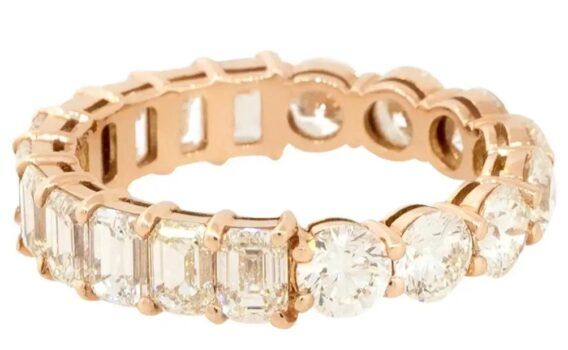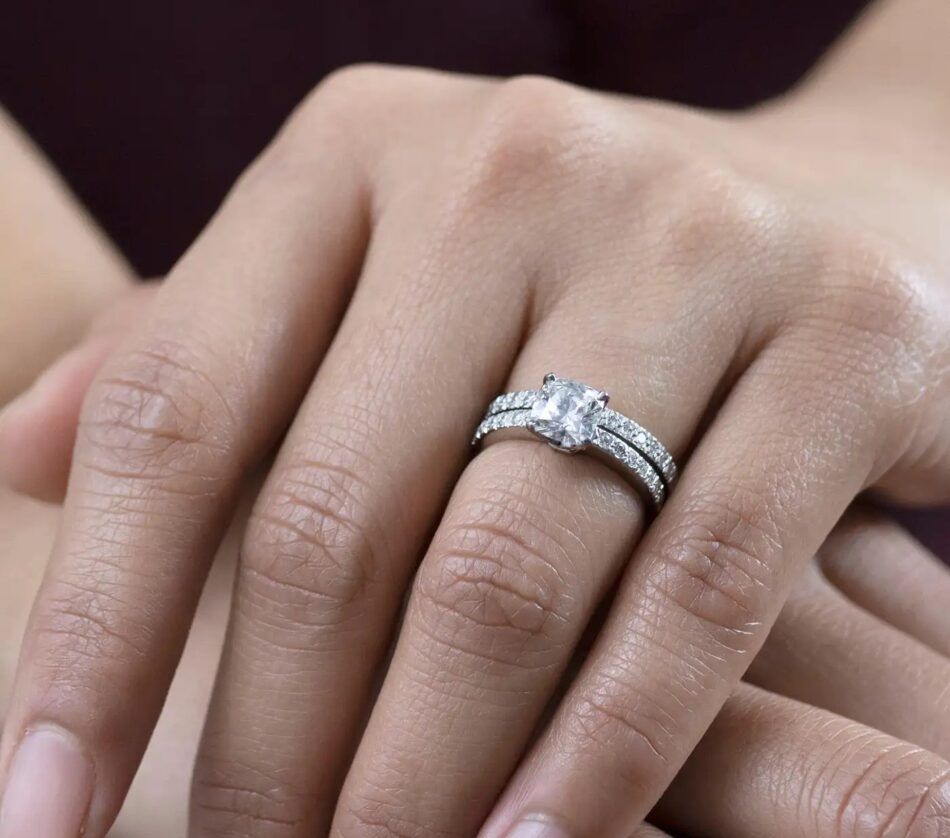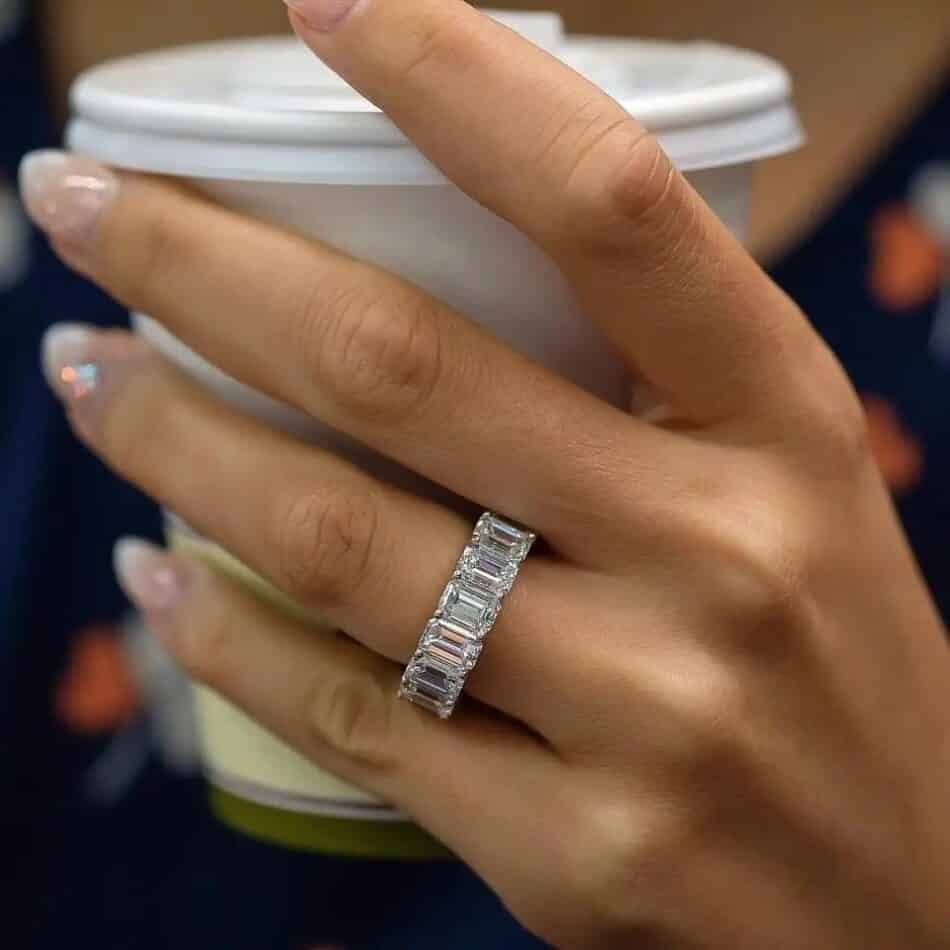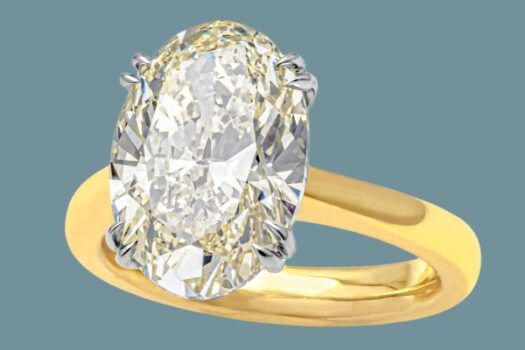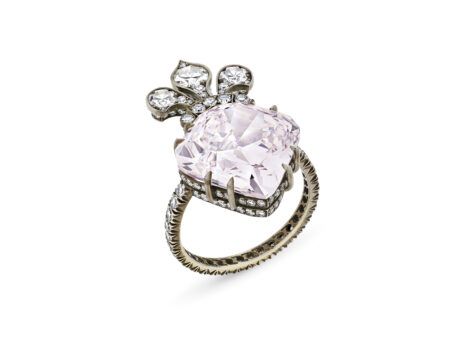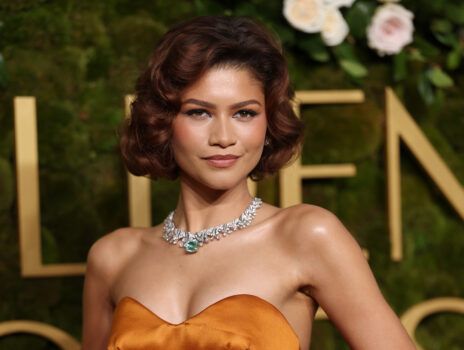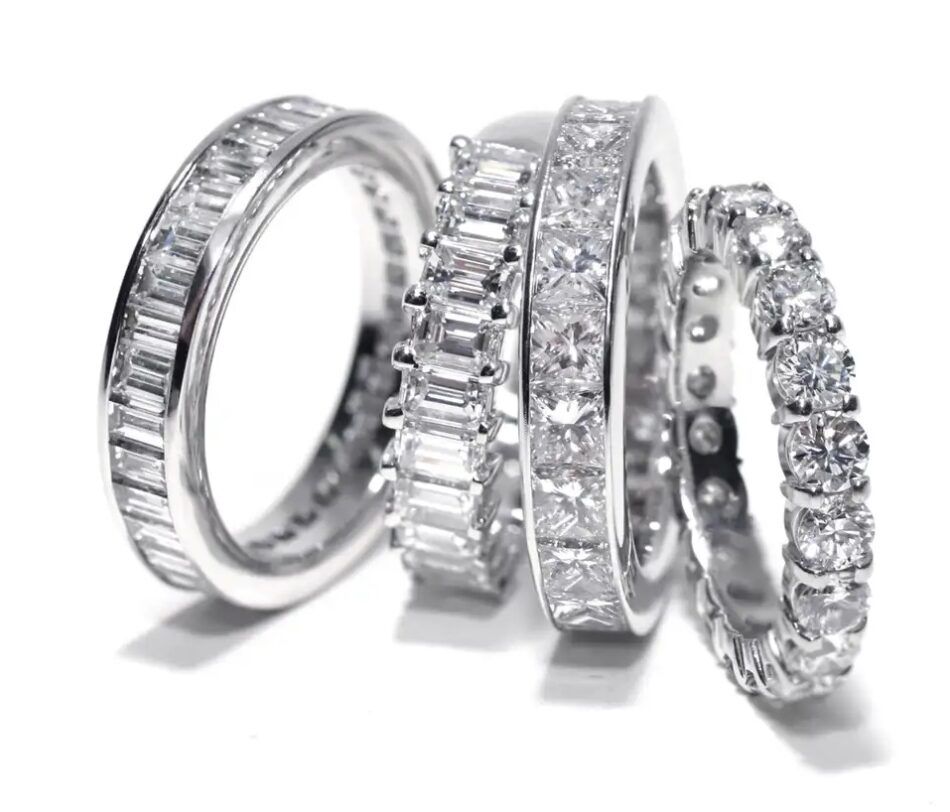
The design is simple and straightforward, yes, but eternity bands are not without nuance. Having originated in the courts of 18th-century Europe, the style is distinguished by a single continuous row of diamonds. This endless circle of light symbolizes a love that’s infinite and everlasting, making it ideal for a wedding band or for marking a milestone anniversary.
An eternity band is also a popular way to commemorate the birth of a child or some other significant life event, such as a 30th birthday or college graduation. A recent high-profile example: When Justin and Hailey Bieber posted photos of their vow renewal on Instagram in May of 2024, they were sporting matching diamond eternity bands. They were expecting their first child at the time, imbuing the rings with extra significance.
Royals favor the style as well. Kate Middleton wears a diamond eternity ring that Prince William is believed to have gifted her after the birth of their first son, Prince George. And in her first official outing after completing chemotherapy in September of 2024, she was wearing a diamond-and-sapphire eternity band, apparently a new addition to her stack, which includes a Welsh gold wedding band. Her sister-in-law Meghan Markle received a Lorraine Schwartz eternity band from Prince Harry on the birth of their son, Archie, in 2019.
History of the Eternity Ring
The shape of a ring, a circle with no beginning or end, has been seen as representing eternity at least since ancient Egyptian times. It wasn’t until the 18th century, however, that gem-set bands were known as eternity rings. And the style didn’t gain momentum until the middle of the 20th century. That was when a trove of diamonds was discovered in Siberia. Smaller than the stones that had become standard for diamond solitaire engagement rings, they were just right for eternity bands.
Mining powerhouse De Beers, which dominated the diamond market, headed off any potential competition by acquiring the Russian stones and popularizing eternity bands. They were originally marketed to couples celebrating their 50th wedding anniversary. But why wait half a century to add some sparkle to your stack? That was certainly the feeling of the influential celebrities who gave the style a boost. Among these perhaps the most famous was Marilyn Monroe, who received a platinum band from Joe DiMaggio that was set with 36 baguette-cut diamonds (and fetched $772,500 at Christie’s in 1999).
Types of Eternity Bands
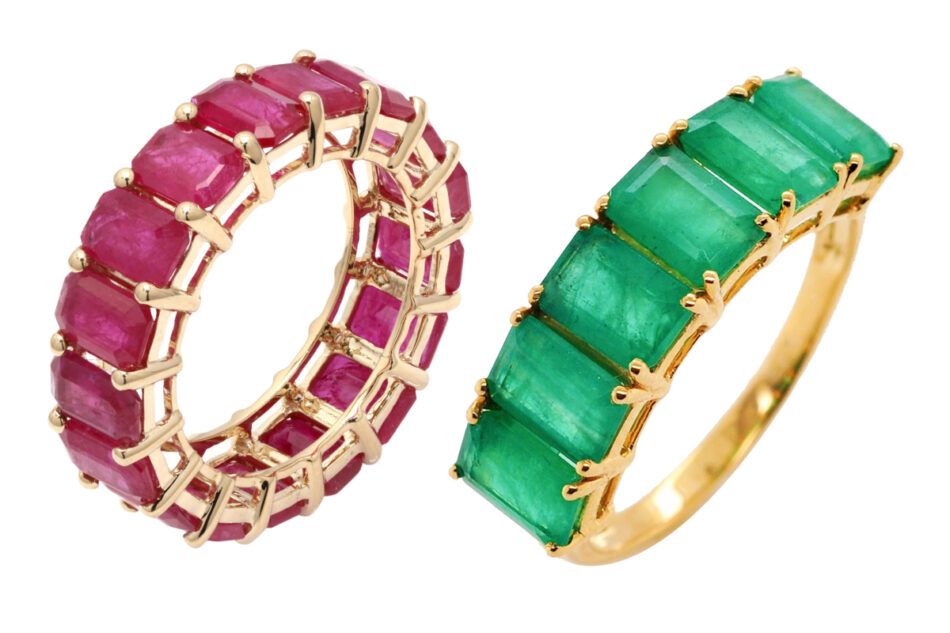
A full eternity band has gemstones all the way around. Resizing a full diamond eternity band isn’t impossible, but it’s a labor-intensive, complex and therefore costly process that many jewelers shy away from. A half eternity band or three-quarter eternity band, with gemstones extending partway around the circumference, leave enough metal to allow for adjustments. If the eternity band is a gift and you’re not sure of the recipient’s ring size, a half or three-quarter eternity band may be the best option. Another benefit: Because they’re made with fewer stones, they are less expensive than full eternity bands, often costing as much as 50 percent less.
Eternity Band Settings
The bands in eternity bands may be set in different ways.
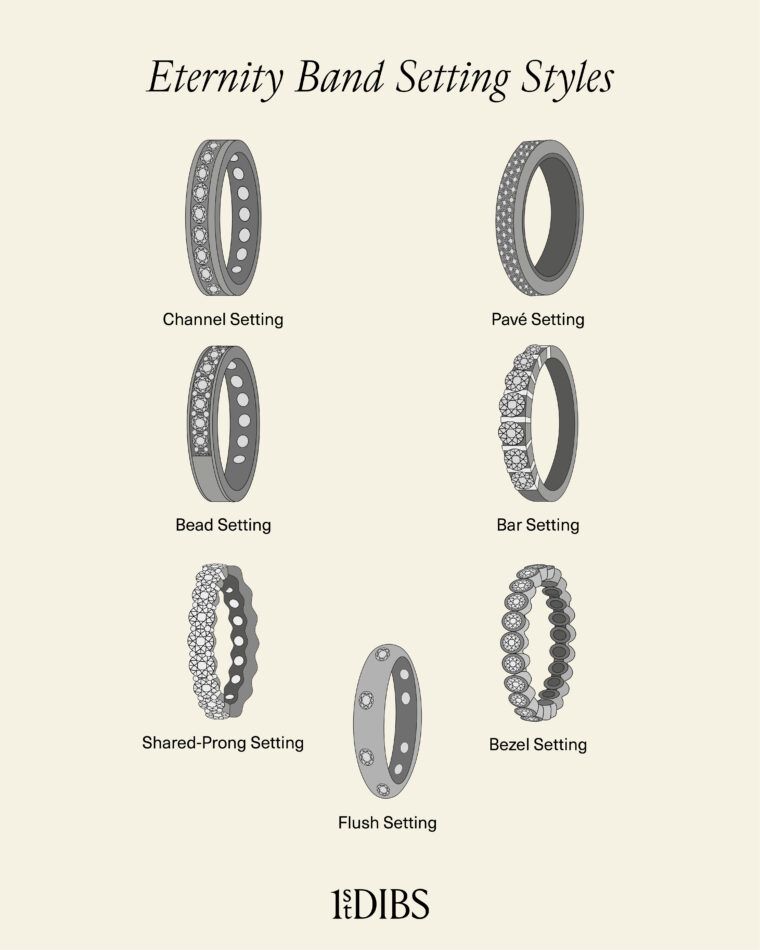
- Channel setting: The diamonds are snugly nestled between two metal rails, producing a neat and tailored look.
- Bead setting: Each diamond is surrounded by — and secured with — tiny metal beads, adding even more sparkle.
- Shared-prong setting: Several prongs cup each diamond, providing extra security.
- Pavé setting: Tiny diamonds are set close together, in a single row or multiple ones, for a seamless “paved” look.
- Bar setting: The diamonds are secured by vertical metal dividers. This is similar to a channel setting, except the diamonds are exposed on two sides, allowing more light to pass through.
- Bezel setting: Each diamond is completely surrounded by a protective metal rim, for a clean and streamlined look. This setting requires more metal to produce, but it holds the stones firmly in place while protecting them from damage.
- Flush setting: The diamonds are fitted into holes drilled into the band, resulting in a level, smooth surface. No prongs means no snagging or catching when you wear the ring. It’s also a great option for setting a handful of small heirloom diamonds in a custom design.
Stone Cuts for Eternity Rings
Eternity rings are most commonly set with round-cut stones. But if you’re feeling creative, you could opt for emerald, princess or Asscher cuts, say, or baguettes, the height of glamour and sophistication.
Rose-cut diamonds, with their antique vibe and muted sparkle, are new favorites among the young and chic. You can also play with the orientation of marquise and oval stones, aligning them horizontally, or “east-west,” along the band instead of vertically. Or you might intersperse colored gems like sapphires or emeralds among the diamonds.
If you can’t decide on your favorite cut, you don’t have to. You could mix shapes — rounds and baguettes, for example — in a dot-dash pattern. Another fun option is to choose a ring with half the stones in one shape, like an emerald cut, and the other half in another shape, like a round brilliant cut. That way you can just twist the ring around for the cut you want to wear that day, or you can wear it so that half of each shows. Three rings in one.
Gemstones for Eternity Bands
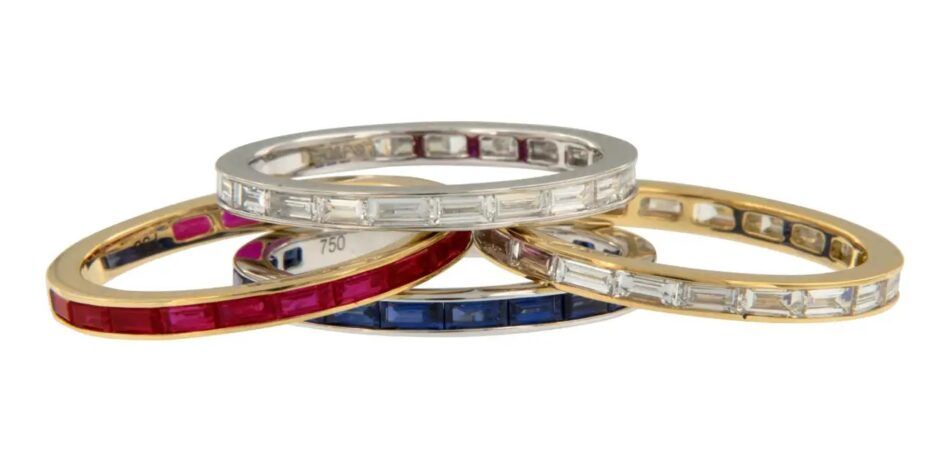
Diamonds — specifically white diamonds — are perhaps the most popular choice when it comes to eternity rings, but there are many more options out there. In addition to other colors of diamonds, like yellow, pink and black varieties, precious gems like sapphires, emeralds and rubies are often used in eternity bands. And you can also find versions with semiprecious stones like amethyst, aquamarine, citrine, peridot, tsavorite, opals and more.
The variety of birthstone gems available in eternity rings makes them a great addition to a ring stack for extra personalization (and a thoughtful gift). It should be noted that an eternity band does not have to be composed of just one type of gemstone — diamonds are often alternated with another precious stone, like emeralds. For particular vibrancy, you could choose rainbow-colored sapphires or gemstones in gradient hues that create an ombré effect.
How to Wear an Eternity Ring
A wedding eternity band, when stacked with an engagement ring, is typically worn on the left hand, at the base of the ring finger (and thus closer to the heart, as is traditional for wedding bands). Experts recommend going with a narrower band, to complement rather than overshadow the engagement ring. Many brides opt for two identical eternity bands, wearing one above and below the engagement ring as guard rings. Curved, chevron or tiara-shaped diamond bands give this time-honored look a modern spin.
There are no rules for wearing diamond eternity bands when fashion is the primary consideration. But if you’re concerned about people mistaking your band for a wedding ring, put it on your right hand — any finger’s fine. There are also no rules when it comes to how many eternity rings you wear, even on the same finger. Much as with bracelets and necklaces, stacking has become a favorite way to wear eternity rings.
How to Stack Eternity Bands
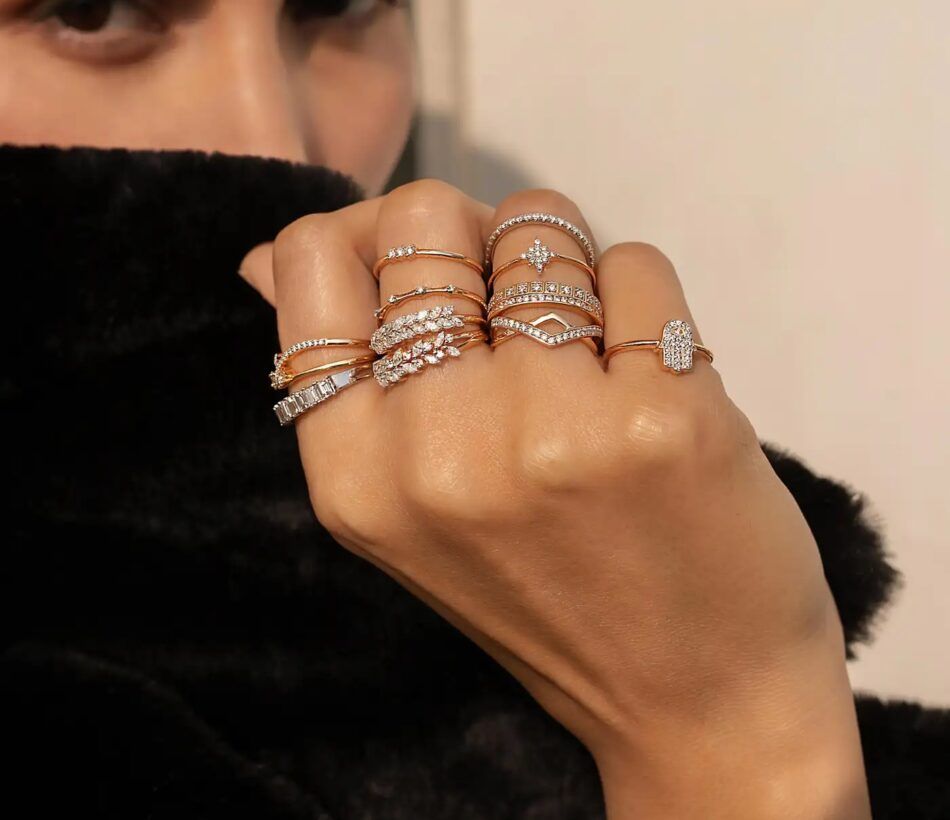
Step aside, brides, just for a moment. Everyone loves eternity bands, and one or a few can provide the perfect foundation for a well-curated ring stack.
If you’ve spent any time on Instagram lately, you know that stacking, or piling several rings on one finger, is a trend in which eternity bands can, and very often do, play a vital role in pulling the combo together. If you’re shopping for an eternity ring to use for this purpose, think slim — not more than 1 to 1.50 mm in width — so that you can fit as many rings on your finger as you want. Feel free to mix metals, settings and stones for a look that pops with personality.
A stack of eternity bands can represent milestones in your life, like earning a degree, getting married, having kids, getting a promotion and celebrating an anniversary. Whether you receive a ring as a gift or buy it for yourself, each one can serve as a wearable reminder of an important moment in your life.
Caring for Eternity Bands
As with any valuable piece of jewelry, eternity rings should be regularly cleaned and inspected by a professional a couple times a year. A jeweler can check the prongs and make sure that there are no loose stones. This is especially important if you have a full eternity band, as the gems are more likely to get knocked around during daily wear. If you have vintage or antique rings, you should have them inspected even more frequently.
Professional jewelers clean diamond rings using commercial-grade ultrasonic machines, which send sound waves through the water. At home, you can make a solution of one-third Windex to two-thirds boiling water and then soak the ring for at least an hour if it’s pretty dirty. You can then scrub it gently with a soft toothbrush and rinse it clean. To dry the ring, you can spray it with a compressed air duster.
Eternally Appealing Eternity Bands
The larger the stones, the more of a statement the eternity band makes. Some couples choose an impressive stand-alone eternity band as an engagement ring and then go with a very plain band for the ring exchanged during the wedding ceremony.
If using an eternity band as your engagement ring appeals to you, you’re in good, star-studded company. In 1956, when Prince Rainier of Monaco and Grace Kelly announced their engagement from her parents’ home in Philadelphia, the actress was wearing a Cartier eternity band set with rubies and diamonds (the prince upgraded to a 12-carat emerald-cut diamond engagement ring when he saw the rocks worn by Kelly’s Hollywood peers). And Audrey Hepburn, the poster child for understated gamine chic, received a Gübelin eternity band of baguette-cut diamonds upon her engagement to Mel Ferrer.
Other high-profile, impossibly chic fans of the eternity band as an engagement ring include filmmaker Sofia Coppola and the late Carolyn Bessette-Kennedy. John F. Kennedy Jr. gave his bride a ring composed of oval-cut diamonds and sapphires, reportedly inspired by his mother Jackie Kennedy’s emerald-and-gold eternity band, which she referred to as her “swimming ring.”
But don’t feel obliged to follow anyone else’s lead. No matter how you style them — whether you wear one meaningful band or artfully curate stacks on both hands — these timeless pieces retain their allure.
